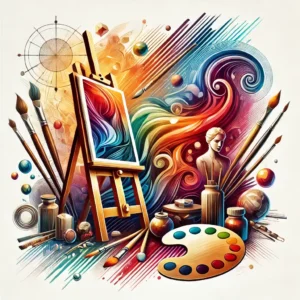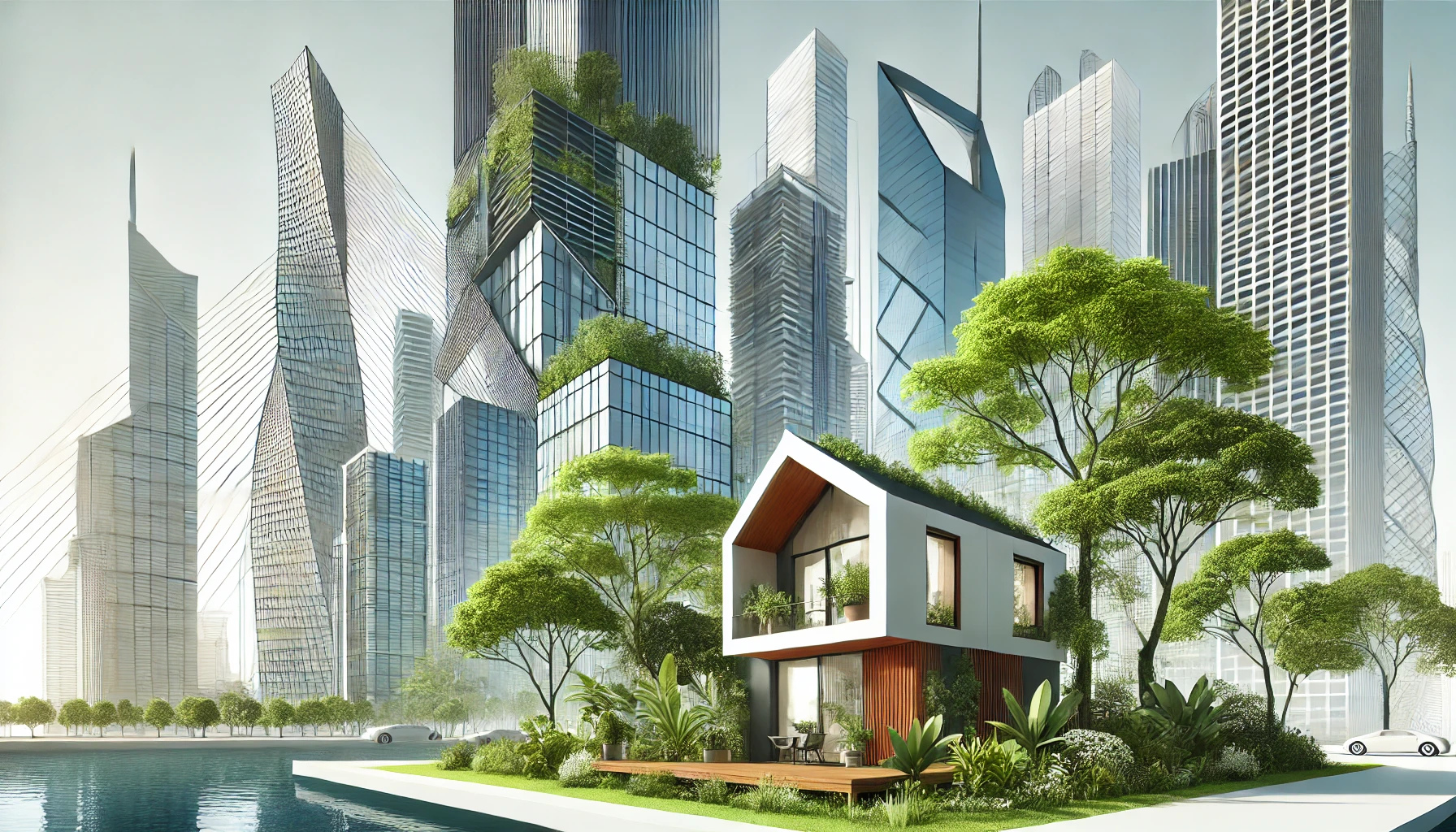Arts, Design, and Media
Exploring Creative Expression and Communication
The fields of Arts, Design, and Media encompass a diverse range of creative disciplines that merge artistic expression with technology, communication, and problem-solving. These fields serve as powerful mediums for storytelling, visualizing ideas, and shaping cultural identity. Whether through painting, digital design, filmmaking, or interactive media, artists and designers craft compelling visuals and narratives that engage, inform, and inspire audiences. As technology evolves, creative professionals integrate new tools and techniques, such as virtual reality (VR), artificial intelligence (AI), and digital fabrication, to push the boundaries of artistic innovation.
Design thinking and media storytelling play a crucial role in how people interact with their environment and consume information. In graphic design, architecture, fashion, and industrial design, professionals focus on balancing form and function to create products that are both aesthetically pleasing and user-friendly. Meanwhile, media specialists in journalism, filmmaking, and digital content creation utilize visual storytelling, motion graphics, and interactive media to convey powerful messages that influence public perception and global discourse. Through multimedia platforms, animation, and augmented reality, these fields enable new ways to communicate ideas and evoke emotions.
As society becomes increasingly digital, the intersection of Arts, Design, and Media with technology is reshaping industries. The integration of data visualization, generative design, and immersive experiences has led to innovations in branding, entertainment, marketing, and education. Additionally, the accessibility of digital tools allows artists and designers to collaborate across disciplines and reach global audiences more easily. Social media, streaming platforms, and virtual exhibitions provide new avenues for creators to showcase their work, breaking traditional barriers of geographical and institutional constraints.
Beyond aesthetics, these disciplines contribute to social change, cultural preservation, and sustainability. Art and media have historically been used to challenge norms, advocate for human rights, and inspire movements. Sustainable design practices, such as eco-friendly materials, ethical fashion, and upcycled art, promote environmental consciousness within creative industries. As the landscape of Arts, Design, and Media continues to evolve, it remains a dynamic force for expression, connection, and transformation in an increasingly visual and media-driven world.

Table of Contents
Key Areas of Focus in Creative Arts, Design, and Media
🎨 Creative Expression and Artistic Innovation
- Cultivate originality, self-expression, and cultural interpretation through visual and performing arts.
- Explore various mediums—from fine art and music to theatre and digital art—that reflect diverse perspectives and identities.
🧠 Design Thinking and Visual Problem Solving
- Apply human-centered design principles that balance functionality, usability, and aesthetics.
- Develop solutions across disciplines such as graphic design, industrial design, fashion, architecture, and user experience (UX) design.
📺 Media Communication and Digital Storytelling
- Learn how to craft compelling narratives and impactful messages across multimedia platforms.
- Master content creation, journalism, advertising, film production, and digital media strategies to engage modern audiences.
Examples of Disciplines in Creative Arts, Design, and Media
1. Fine Arts
- Focus: The visual and tactile exploration of creative expression through mediums like painting, sculpture, and drawing.
- Key Areas:
- Traditional mediums: Oil painting, watercolor, clay sculpture.
- Contemporary practices: Installation art, conceptual art, mixed media.
- Art history: Studying artistic movements and cultural contexts.
- Applications:
- Creating public and private art collections.
- Preserving cultural heritage and fostering societal reflection.

2. Performing Arts
- Focus: The live expression of human emotions and stories through music, theatre, and dance.
- Key Areas:
- Music: Composition, performance, and sound engineering.
- Theatre: Acting, directing, stage design, and playwriting.
- Dance: Choreography, performance, and cultural dance studies.
- Applications:
- Entertainment industry (concerts, films, stage productions).
- Therapy and wellness through music and movement programs.

3. Graphic Design
- Focus: Visual communication through typography, imagery, and layout.
- Key Areas:
- Branding and identity: Logo design, corporate visual identity.
- Digital design: UI/UX design for apps and websites.
- Print media: Posters, brochures, and packaging.
- Applications:
- Enhancing brand visibility and consumer engagement.
- Supporting marketing and advertising campaigns.

4. Architecture
- Focus: The design and construction of buildings and spaces that are functional, aesthetic, and sustainable.
- Key Areas:
- Urban planning: Designing public spaces and cityscapes.
- Sustainable architecture: Eco-friendly materials and energy-efficient designs.
- Interior design: Creating harmonious and functional interior spaces.
- Applications:
- Urban development and infrastructure projects.
- Restoration and conservation of historical sites.

5. Film and Media Studies
- Focus: The analysis and creation of visual storytelling through cinema, television, and digital media.
- Key Areas:
- Film production: Directing, cinematography, editing.
- Media analysis: Examining cultural, social, and political influences on media.
- Scriptwriting: Crafting compelling narratives for screen content.
- Applications:
- Producing films, documentaries, and web series.
- Shaping cultural narratives and social discourse.

6. Journalism
- Focus: Investigating and reporting events to inform the public while upholding truth and ethical standards.
- Key Areas:
- Investigative journalism: In-depth reporting on critical issues.
- Broadcast journalism: Reporting via television, radio, and online platforms.
- Photojournalism: Capturing visual stories of events and people.
- Applications:
- Supporting democracy through informed citizenry.
- Covering global, national, and local events across media platforms.

7. Advertising
- Focus: Crafting persuasive messages to promote products, services, or ideas.
- Key Areas:
- Campaign strategy: Planning multi-platform marketing campaigns.
- Creative development: Designing visuals and copy for ads.
- Media planning: Selecting appropriate channels to reach target audiences.
- Applications:
- Driving consumer engagement and brand loyalty.
- Enhancing visibility for startups and global corporations.

8. Public Relations
- Focus: Managing an organization’s image and fostering positive relationships with stakeholders.
- Key Areas:
- Crisis management: Handling public perception during challenges.
- Media relations: Building relationships with journalists and media outlets.
- Event planning: Organizing promotional and community events.
- Applications:
- Improving corporate reputation and stakeholder trust.
- Managing public campaigns for nonprofits and government organizations.

9. Digital Communication
- Focus: Leveraging digital platforms to connect and communicate with audiences.
- Key Areas:
- Social media management: Engaging audiences on platforms like Instagram, Twitter, and LinkedIn.
- Content creation: Producing blogs, videos, podcasts, and interactive media.
- Analytics and optimization: Measuring performance and improving strategies.
- Applications:
- Building online communities and enhancing brand visibility.
- Driving e-commerce growth and digital marketing campaigns.

Relevance and Real-World Applications of Arts, Design, and Media
🌍 Cultural Impact and Identity Preservation
- Foster cultural continuity and innovation by expressing heritage, values, and diversity through visual arts, music, film, and literature.
- Strengthen community identity and global understanding through creative storytelling and artistic expression.
💼 Economic Contribution and Creative Industries Growth
- Power key sectors such as entertainment, media production, publishing, advertising, fashion, and digital design.
- Generate employment and entrepreneurial opportunities in the expanding global creative economy.
📣 Social Influence and Public Engagement
- Shape public discourse, influence societal values, and raise awareness on global and local issues through persuasive design and multimedia communication.
- Empower advocacy, education, and behavioral change through impactful visual messaging and storytelling.
Core Skills Developed in Creative Fields
Visual communication and design principles
Critical thinking and conceptual development
Storytelling and audience engagement techniques
Technical proficiency in tools such as Adobe Creative Suite, video editing software, or CAD tools
Collaboration, project management, and cross-disciplinary teamwork
Lifelong Relevance Beyond University
Creative thinking skills are transferable across sectors including business, education, marketing, and tech.
Artistic expression enriches personal growth, cultural appreciation, and social contribution.
Design literacy empowers you to communicate ideas effectively in a visual-first world.
Future Trends and Emerging Opportunities
Immersive media: AR/VR, interactive design, and gamified storytelling
Sustainable and ethical design practices
Digital content creation and AI-enhanced media production
Cross-cultural collaboration in global creative networks
Evolving roles in transmedia storytelling and creative entrepreneurship
Conclusion: Begin Your Creative Journey
At Prep4Uni.online, we celebrate the power of creativity to transform how we live, work, and connect. Explore your path in arts, design, and media — and equip yourself with the skills, knowledge, and inspiration to thrive in the creative industries of tomorrow.
Review Questions and Answers:
1. What are the primary disciplines covered under arts, design, and media?
Answer: They include visual arts (painting, sculpture, photography), design (graphic, industrial, interior), and media (film, digital, broadcasting), each emphasizing creativity, communication, and aesthetic expression.
2. How does design integrate functionality with aesthetics?
Answer: Design balances visual appeal with usability by combining creative elements with practical considerations, ensuring that products are both attractive and effective in meeting user needs.
3. What role does digital media play in modern artistic expression?
Answer: Digital media expands creative possibilities through tools like graphic design software, digital photography, and video production, enabling innovative ways to create, share, and experience art.
4. How can understanding color theory enhance a designer’s work?
Answer: Color theory helps designers create harmonious and impactful visuals by understanding color relationships, contrasts, and the psychological effects of different hues.
5. What is the importance of visual communication in media?
Answer: Visual communication uses images, typography, and layout to convey messages effectively, making information more accessible and engaging for diverse audiences.
6. How does the evolution of technology impact the fields of arts, design, and media?
Answer: Technological advancements lead to new creative tools and platforms, transforming traditional practices and enabling innovative forms of expression and interactive media experiences.
7. What skills are essential for a successful career in creative industries?
Answer: Critical skills include creativity, technical proficiency in design software, strong communication, problem-solving abilities, and an understanding of visual and digital media trends.
8. How does storytelling influence media production?
Answer: Storytelling is central to media production as it engages audiences, conveys emotions, and communicates messages effectively, whether in film, digital content, or advertising.
9. What is the significance of interdisciplinary collaboration in creative projects?
Answer: Interdisciplinary collaboration combines diverse expertise, fostering innovative ideas and solutions that enhance the quality and impact of creative projects across arts, design, and media.
10. How do sustainability and ethics factor into modern creative practices?
Answer: Sustainable and ethical practices ensure that creative projects minimize environmental impact and respect cultural and social values, which is increasingly important for responsible and forward-thinking professionals.
Thought-Provoking Questions and Answers
1. How might emerging technologies reshape traditional art and design practices?
Answer: Emerging technologies such as augmented reality, virtual reality, and AI-driven design tools are revolutionizing how art is created and experienced. These innovations allow for immersive installations, interactive media, and personalized design experiences that challenge conventional methods and expand creative boundaries.
2. In what ways can digital media democratize artistic expression?
Answer: Digital media provides accessible platforms for creators to share their work globally, breaking down geographical and financial barriers. This democratization fosters diverse voices and perspectives, enriching cultural dialogues and enabling independent artists to thrive without traditional gatekeepers.
3. How does the integration of sustainability principles influence design and media projects?
Answer: Incorporating sustainability in design and media projects leads to eco-friendly materials, energy-efficient production methods, and campaigns that promote environmental awareness. This integration not only reduces ecological impact but also appeals to increasingly conscious consumers and audiences.
4. What challenges do artists and designers face when balancing creativity with commercial viability?
Answer: Artists and designers must navigate market demands, client expectations, and budget constraints while maintaining creative integrity. This balance requires strategic thinking, effective communication, and the ability to adapt innovative ideas to practical and financially viable projects.
5. How can interdisciplinary collaborations enhance the impact of creative projects?
Answer: Collaborations across disciplines bring together diverse perspectives, skills, and technologies, leading to groundbreaking projects that transcend traditional boundaries. This synergy often results in richer, more engaging, and multifaceted works that resonate with broader audiences.
6. In what ways might social media influence trends in arts, design, and media?
Answer: Social media platforms rapidly disseminate creative content, shaping trends and consumer preferences. They provide immediate feedback, foster community engagement, and allow creators to experiment with new styles, ultimately driving innovation and evolution within the creative industries.
7. How does the concept of visual storytelling impact branding and marketing strategies?
Answer: Visual storytelling enhances branding by creating memorable, emotionally resonant narratives that connect with consumers. It allows brands to communicate their identity and values effectively, fostering loyalty and differentiation in competitive markets.
8. What role does cultural context play in the interpretation and creation of art and design?
Answer: Cultural context influences both the creation and reception of art and design by shaping the symbols, narratives, and aesthetics that resonate with audiences. Understanding cultural nuances enables creators to produce work that is meaningful and relevant in diverse global contexts.
9. How can emerging design technologies, such as 3D printing, transform traditional manufacturing processes?
Answer: 3D printing enables rapid prototyping, customization, and the production of complex geometries that are difficult or impossible to achieve with traditional methods. This technology can streamline manufacturing, reduce waste, and foster innovation in product design.
10. In what ways might the convergence of arts, design, and media lead to new forms of interactive and immersive experiences?
Answer: The convergence enables the creation of multi-sensory experiences that blend visual art, sound, and interactive elements. This fusion can result in immersive installations, virtual reality environments, and interactive media that redefine audience engagement and storytelling.
11. How could advancements in computational design tools influence the future of creative industries?
Answer: Computational design tools enable rapid iteration, complex simulations, and data-driven creativity, allowing designers to optimize aesthetics and functionality. These advancements can lead to highly customized products, innovative art forms, and more efficient design processes across industries.
12. What ethical considerations should guide the use of digital and emerging technologies in creative practices?
Answer: Ethical considerations include data privacy, intellectual property rights, and the potential for digital divide issues. Responsible use of technology in creative practices ensures equitable access, respects cultural diversity, and promotes transparency and sustainability in the production and distribution of creative work.
Numerical Problems and Solutions
1. A creative agency allocates a budget of $50,000 for a multimedia project. If 30% of the budget is spent on design and 20% on production, how much remains for marketing and distribution?
Solution:
Amount spent = 30% + 20% = 50% of $50,000 = $25,000
Remaining budget = $50,000 – $25,000 = $25,000.
2. A digital display has a resolution of 1920×1080 pixels over a 50-inch diagonal. Calculate the approximate pixel density (PPI).
Solution:
Diagonal in pixels = √(1920² + 1080²) ≈ √(3,686,400 + 1,166,400) = √(4,852,800) ≈ 2203 pixels.
50 inches diagonal gives PPI = 2203 / 50 ≈ 44.06 PPI.
3. An artist prints a poster measuring 24 inches by 36 inches. Calculate its area in square centimeters. (1 inch = 2.54 cm)
Solution:
Dimensions in cm: 24 in = 60.96 cm, 36 in = 91.44 cm
Area = 60.96 cm × 91.44 cm ≈ 5573.5 cm².
4. A graphic designer needs to scale an image from 800×600 pixels to a width of 1200 pixels while maintaining the aspect ratio. Calculate the new height.
Solution:
Aspect ratio = 600/800 = 0.75
New height = 1200 × 0.75 = 900 pixels.
5. A video project requires a frame rate of 30 fps. How many frames are there in a 2-minute video?
Solution:
Total seconds = 2 × 60 = 120 s
Total frames = 120 s × 30 fps = 3600 frames.
6. In a design project, a poster’s resolution must be 300 DPI (dots per inch). What is the minimum number of dots required for a 18-inch by 24-inch poster?
Solution:
Dots per side: 18 in × 300 = 5400 dots; 24 in × 300 = 7200 dots
Total dots = 5400 × 7200 = 38,880,000 dots.
7. A photographer uses a camera with an aperture of f/2.8. If the lens focal length is 50 mm, calculate the diameter of the aperture opening.
Solution:
Aperture diameter = focal length / f-number = 50 mm / 2.8 ≈ 17.86 mm.
8. A digital art file is 15 MB in size. If it is compressed to 40% of its original size, what is the new file size in MB?
Solution:
New file size = 15 MB × 0.40 = 6 MB.
9. A website loads an image in 0.5 seconds. If the image is 2 MB in size, calculate the effective download speed in MB/s.
Solution:
Download speed = 2 MB / 0.5 s = 4 MB/s.
10. A designer prints a brochure with a 4-color process. If each brochure costs $0.25 to print and 10,000 copies are made, what is the total printing cost?
Solution:
Total cost = 10,000 × $0.25 = $2500.
11. In a video editing software, a timeline is 120 seconds long and is divided into 3600 frames. What is the average duration of each frame in seconds?
Solution:
Duration per frame = 120 s / 3600 frames = 0.0333 s per frame.
